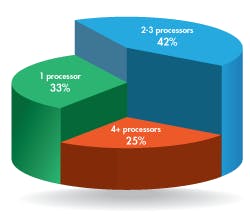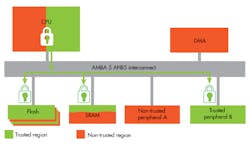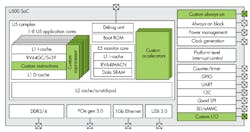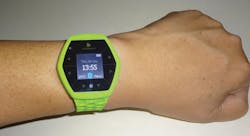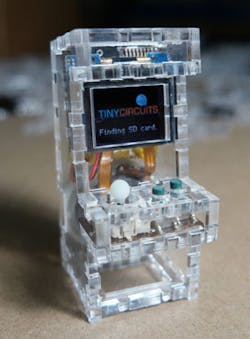This file type includes high resolution graphics and schematics when applicable.
Overall, 2016 has been an amazing year, from a variety of viewpoints. Significant consolidation has occurred in all areas, from Silicon Labs buying Micrium for its µC/OS RTOS family to Mercury Systems acquiring Creative Electronic Systems. There were major purchases in the semiconductor space as well. Analog Devices picked up Linear Technology, while Broadcom became part of Cypress Semiconductor. Of course, there was also Qualcomm's acquisition of NXP, which had recently absorbed Freescale. Softbank's purchase of ARM will have major implications in this space, too.
Processor Technology
The Barr Group's latest survey shows a major movement toward multicore solutions (Fig. 1), and vendors are churning out new architectures and chips to meet the demand. One of the most significant announcements for the Internet of Things (IoT) space was ARM's new Cortex-M23 and -M33 series based on the ARMv8-M architecture. The architecture includes ARM TrustZone support for hardware isolation of code, data, and peripherals (Fig. 2). Chips based on the new architecture will be available next year, providing a more secure programming platform for embedded applications.
The other ARM platform of note is the Cortex-R52 that targets safety critical applications such as automotive driver assistance systems (ADAS) and even self-driving cars. It is designed to meet IEC 61508 SIL 3 and ISO 26262 ASIL D requirements. The primary feature of this multicore platform is the hardware that implements the software separation scheme similar to virtual-machine support found in ARM application processors.
The Cortex-R52 is different because it has a memory protection unit (MPU)—as opposed to a virtual memory management unit (MMU)—because it has a single address space. It just provides protected partitions so that tasks can be isolated. This allows the use of a sandbox hypervisor, and the system can provide deterministic performance necessary for safety critical applications.
Imagination Technologies' 64-bit I6400 Warrior core is designed to be part of a heterogeneous cluster. A cluster of eight cores is a building block for larger systems that can have up to 64 clusters, and which can handle 1,536 simultaneous threads and support 128 I/O control units (IOCUs). Imagination Technologies' PowerVR GPUs can also be part of the mix. The system supports the OmniShield IO virtualization technology, which allows secure virtual domain to include a mix of hardware cores. ADAS is just one application area for this type of system.
RISC-V (risk-five) is a compact instruction set architecture (ISA) that can address a range of systems, including 16-, 32-, 64-, and 128-bit platforms. The ISA supports a mix of hardware functions like floating point and SIMD. The small instruction set makes it possible to define additional instructions, suiting it for embedded applications.
SiFive's Freedom family is an open-source chip platform based on RISC-V. Freedom U500 (Fig. 3) and Freedom E300 work with both FPGA or ASIC implementations. The Freedom U500 can run Linux and is designed for TSMC's 28-nm technology. The Freedom E300 microcontroller is designed for low-power IoT applications and uses TSMC’s 180-nm technology. SiFive’s platform includes a board support package and development boards in addition to the base silicon.
Microsemi is making RISC-V available on its SmartFusion 2 SoC FPGAs. There is no charge for using RISC-V, unlike the ARM Cortex-M1 that is also available for the SmartFusion 2 chips. Designs can be moved from an FPGA to a custom chip without incurring additional license fees.
RISC-V is supported by a range of open-source development tools, including GCC and LLVM compilers. The implementations that support Linux can take advantage of the Yocto configuration tools.
Supercomputing Technology
Intel's Xeon still dominates the high-end enterprise environments, but it is finally getting more competition from 64-bit ARM platforms like Cavium's ThunderX2. Configuration support up to 100-Gb Ethernet and the Cavium Coherent Processor Interconnect (CCPI) provide cache-coherent operation in a dual-socket configuration. AMD's Opteron-A and Applied Micro's X-Gene server chips fit in this space. Standard Linux distributions are available for these platforms.
Applications that incorporate deep learning, or deep neural nets (DNNs), are becoming more common. Systems are being designed to handle these applications using approaches that range from many core solutions to GPGPUs.
Intel's Knights Landing Xeon Phi is a multicore solution that has built-in support for Intel's OmniPath fabric. The OmniPath fabric allows for the creation of very large supercomputer clusters with thousands of cores. Unlike earlier Xeon Phis, the latest can act as a host; therefore, a cluster can consist solely of Xeon Phi chips.
Nvidia's Tesla P100 GPGPU (Fig. 4) is designed to tackle DNN, among other applications. It can deliver 21 TFLOPS of 16-bit floating point that is ideal for DNN applications. It is built using CoWoS (chip-on wafer-on-substrate) with HBM2 (high-bandwidth memory version 2) technology. Four high-speed NVLinks can connect multiple chips into a single node without additional logic. The P100 can run the Cuda DNN (cuDNN) runtime that targets DNN frameworks like TensorFlow, an open-source software library for numerical computation.
Embedding FPGA Technology
Flex Logix and Menta are delivering embedded FPGA (eFPGA) technology. An eFPGA allows an ASIC to provide fixed custom hardware, as well as configurable custom hardware.
The eFPGA block works like a conventional FPGA, except that it is embedded in a chip with other logic. It allows companies to provide a chip with a configurable interface as well as reconfigurable hardware acceleration. The approach can help future-proof a design, and and be used to prevent third parties from copying a chip’s functionality.
On top of that, the eFPGA approach allows more flexible, single-chip solutions, since the embedded FPGA eases interface support.
The Virtual Experience
Augmented reality (AR), mixed reality (MR), and virtual reality (VR) were hot topics this year, led by a number of wearable glasses (like Microsoft's HoloLens) that provide an immersive environment. While VR and MR require this immersive approach, AR does not. AR can utilize devices like smartphones and cameras that are equipped with cameras.
Scope AR's WorkLink (Fig. 5) is one platform that fits the bill. The software is able to recognize objects in view of the camera and overlay additional information. It can be used for applications such as training and maintenance. WorkLink supports glasses as well as smartphones and tablets. The Remote AR package allows a remote person to see and interact with the person running WorkLink.
Virtual experiences are no longer limited to sight and sound. Now touch can be part of the mix using Ultrahaptics' latest technology. The system uses an array of tiny ultrasonic speakers combined with a 3D camera to deliver focused vibrations to a person’s skin, such as the palm of their hand. It provides feedback without the need to actually touch a surface. The technology can simulate many different types of textures and effects and combine them with AR or VR interaction.
MyScript’s Nebo is not an AR or VR application, but it is changing how we interact with devices. Nebo is actually a pen-based editing tool that runs on smartphones and tablets. It provides word-processing-style editing capabilities using a stylus so that handwritten notes can be turned into editable content. The key is portable data storage akin to the ubiquitous DOC file, but with script annotations and information. Like AR and VR, this is something that you really need to see to appreciate how effective it can be and how different it is from conventional stylus interactions with a computer.
I have written and tested a wide range of platforms for IoT applications. No single one addresses everyone's needs, but I wanted to mention two that impressed me. The first is NXP's Hexiwear. Hexiwear (Fig. 6) is a hexagonal module with a touch interface and display that can also be mounted in a wrist strap to take advantage of the built-in heart-rate monitor (HRM). The HRM is an LED/sensor combination on the back of the module. It has Bluetooth Low Energy and 802.15.4 connectivity.
Hexiwear is probably the closest you can come to a wrist-based IoT device without having to design a custom system. Of course, the idea is to be able to quickly prototype an application so that it can be turned into a custom design. The main board inside the module has an expansion connector that also allows the module to be plugged into a breakout board with sockets for up to three MikroElektronika Click Boards.
The other platform is TinyCircuits’ array of postage stamp-sized boards that can be stacked to form some impressively tiny systems. These boards include a Tinyscreen OLED TinyShield and the Tinyduino processor board that is comparable to an Arduino Uno board. You can even get a Tiny Arcade (Fig.7) that is built from the boards. The Tiny Arcade uses the processor and OLED screen. It adds audio output via a built-in speaker, a rechargeable battery, and a tiny joystick and buttons.
I did want to mention NanoDimension’s DragonFly 2020. This 3D printer creates printed circuit boards (PCBs) using inkjet deposition. The multilayer boards are comparable in size and electrical performance to conventional PCBs, except that the DragonFly uses nanoparticle inks.
That’s it for now.
This file type includes high resolution graphics and schematics when applicable.
About the Author
William G. Wong
Senior Content Director - Electronic Design and Microwaves & RF
I am Editor of Electronic Design focusing on embedded, software, and systems. As Senior Content Director, I also manage Microwaves & RF and I work with a great team of editors to provide engineers, programmers, developers and technical managers with interesting and useful articles and videos on a regular basis. Check out our free newsletters to see the latest content.
You can send press releases for new products for possible coverage on the website. I am also interested in receiving contributed articles for publishing on our website. Use our template and send to me along with a signed release form.
Check out my blog, AltEmbedded on Electronic Design, as well as his latest articles on this site that are listed below.
You can visit my social media via these links:
- AltEmbedded on Electronic Design
- Bill Wong on Facebook
- @AltEmbedded on Twitter
- Bill Wong on LinkedIn
I earned a Bachelor of Electrical Engineering at the Georgia Institute of Technology and a Masters in Computer Science from Rutgers University. I still do a bit of programming using everything from C and C++ to Rust and Ada/SPARK. I do a bit of PHP programming for Drupal websites. I have posted a few Drupal modules.
I still get a hand on software and electronic hardware. Some of this can be found on our Kit Close-Up video series. You can also see me on many of our TechXchange Talk videos. I am interested in a range of projects from robotics to artificial intelligence.


